This week in Green Energy Futures CKUA Radio Podcast we talk to Ilana Weitzman of Electric Autonomy Canada about barriers to EV adoption and what EV owners really need.
By David Dodge, GreenEnergyFutures.ca
Electric Autonomy Canada wanted to find out what’s holding people back from making the switch to electric vehicles and what the electric fueling station of the future looks like, so they conducted a survey.
“We conducted the survey as part of our journey on a design competition that we’re holding to imagine the electric fueling station of the future,” says Ilana Weitzman, VP of Strategic Development.
Electric Autonomy Canada is a news platform “designed to accelerate the transition to cleaner, safer, and more affordable transportation.”
The survey reveals what the barriers to adoption are and what EV drivers need in the form of vehicle charging stations.

Barriers to EV adoption
- To test drive is to love
“I think the biggest barrier is that people haven’t been in EVs,” says Weitzman. Fully “66% of Canadians have never actually been inside an electric vehicle.”
Supply is a big part of this. “Half of national dealerships in 2021 had no or very low inventory of zero-emissions vehicles,” says Weitzman.
Yet despite the lack of inventory, fully 51% of Canadians have considered purchasing or leasing a vehicle that runs on electricity and 25% are “very” interested.
- Cost of EVs
Cost is another barrier: “63% of people feel that they’re just too expensive”, says Weitzman. But this is changing fast. Nissan dropped the price of its popular Leaf models by $4,000 to 6,000 last year. Automakers are investing more than $500 billion in more than 500 models of EVs that are due out by 2025. Economies of scale and price competition will change continue to drive costs down dramatically.
- Charging Availability
Just over half of Canadians also worry about the availability of publicly available charging stations as well as the initial cost of installing an EV charger at home which ranges from $500 to $2,000.
- Range Anxiety
And 44% of Canadians still worry about range and how far an EV can go. “So, I think that there is a lot to be done on education because, in a lot of ways, some of those barriers don’t really exist. Weitzman says the newer EVs have a range of about 350 kilometers, with long range versions reaching 500 kilometers. (a fully maintained Honda Odyssey has to refuel at approximately 570 kilometers)
“So that’s a heck of a far drive. If you’re not stopping after 500 kilometers, that’s an issue,” says Weitzman.

Charging EVs – What drivers really need
Needless to say, driving EVs is a very different experience than driving gas-fueled cars. The technology is different, there’s no oil and the primary refueling station is the home. Many EV owners installed faster level II chargers in their garages.
EV drivers leave home fully charged every day. This makes commuting to work, going shopping, or running errands effortlessly. You come back from the mall, plugin and you’re fully charged again before you take the kids to hockey practice.
Heading out on the highway is when charging and range considerations come into play. That’s when EV drivers really need fast-charging stations sprinkled along highways.
“I think what’s interesting, is that typically a recharge stop for an EV is going to be a little bit longer. You’re going to be stopping for maybe 20 to 40 minutes,” says Weitzman.
Conventional gas stations aren’t designed for this. And worse yet, all too often charger stations are placed willy-nilly at grocery stores and other opportunistic locations without any facilities whatsoever.
“You don’t necessarily have washroom facilities available. You might not even have a bench to sit on. You might be sitting there in a snowstorm with no protection. So, I think the first thing that EV drivers would really like is infrastructure that’s built for them,” says Weitzman.
Sure, EV drivers need the basics, a squeegee to clean the windows, a washroom, and maybe a coffee. But what else?
Charging Station of the Future
“It actually gets interesting from there. So, there are all kinds of other activities you could do,” says Weitzman. You could be reading a book, streaming a movie in a lounge, going for a walk grabbing a bite or enjoying some downtime at picnic tables.
In short, the conventional gas station needs to be reinvented from the ground up for EV drivers. Electric Autonomy Canada saw an opportunity here.
“We opened up an international ideas competition asking architects worldwide to imagine what the electric fueling station of the future could look,” says Weitzman.
They put up $40,000 in prize money and were floored with the response. We’ve had entries from Kazakhstan, Portugal, Italy, the UK, Canada, China – it’s been fantastic,” says Weitzman.
More than 100 architects and designers responded from around the world wanting to participate in designing the Electric Fueling Station of the Future.
Next week Ilana Weitzman reveals the winning designs.

